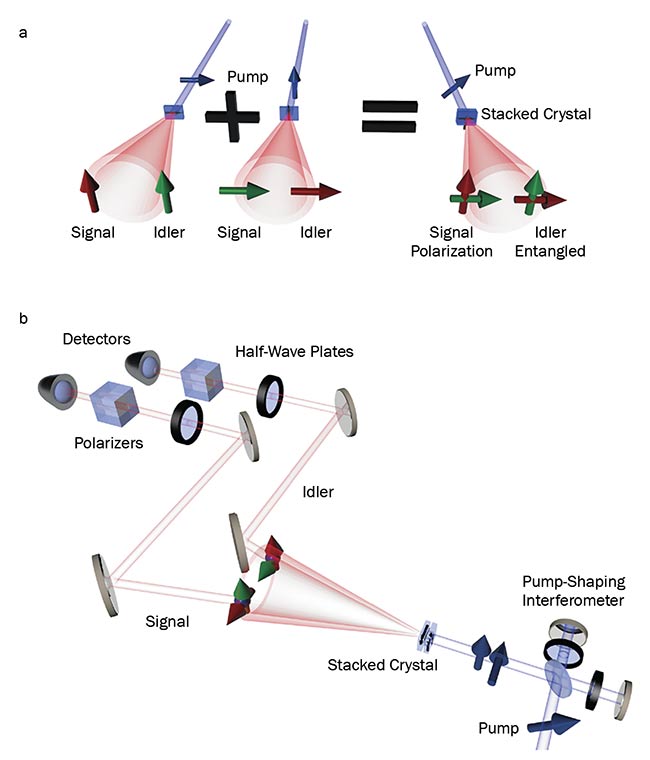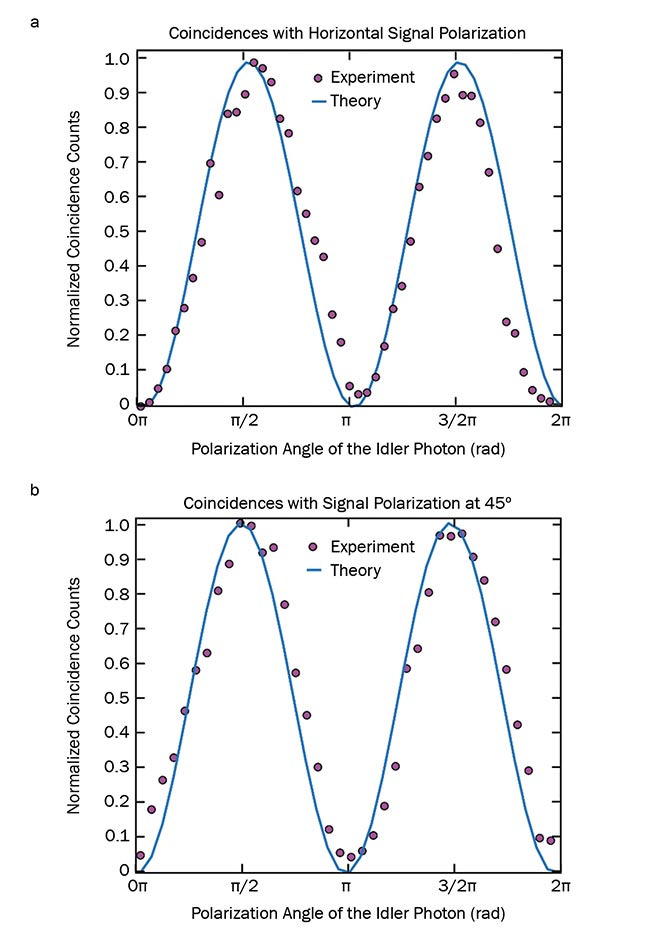As quantum technologies and their market opportunities advance, an innovative partnership demonstrates the need for application-specific standards for entangled states.
CHRISTOPHER LEBURN, CHROMACITY LTD., and MATTEO CLERICI AND BIENVENU NDAGANO, UNIVERSITY OF GLASGOW
Entangled photons are key to the development of optical quantum technologies such as enhanced metrology, computing, and communication. It is projected that the global quantum communications market will reach $1.53 billion by 2023, with an estimated growth rate of more than 25% per year1,2. In metrology, quantum-enhanced optics enables new levels of sensitivity in the measurement of minute changes in the structure of space, such as those induced by gravitational waves. Markets for quantum communications include telecommunications, security, and defense. Markets for sensing, imaging, and metrology include civil engineering, safety control, health care, and the exploitation of natural resources.
In recognition of the importance of the quantum market, governments and businesses are investing hundreds of millions of dollars to stimulate the translation of quantum mechanics — one of the most successful scientific theories of all time — into new quantum technologies for the benefit of citizens. While most of the growth will require long-term investment (>10 to 15 years), products for sensing, metrology, and communications could be available within five years3,4.
To date, researchers and companies addressing the expansion of the quantum metrology and information markets have mostly relied on custom-built sources
of entangled states. This is a time-consuming, ad hoc exercise, which hinders the diffusion of a quality standard
for entangled states. A defined standard for quantum key distribution (QKD) is currently one of the main objectives of the European Telecommunications Standards Institute5.
Entanglement off the shelf
The market for entangled photon sources is at an early stage, with commercial products available from only a small number of companies. Products offered by these companies typically deliver entangled photons at around 1500 nm because of the broad availability of laser sources able to produce entangled photons at around this wavelength. This wavelength is also compatible with current fiber optic networks. The use of entangled photons in the visible spectrum, however, is attractive because it requires a relatively small investment for detectors. In the visible-NIR region, silicon single-photon avalanche diodes (SPADs) can be used as detectors. They are relatively low cost, widely available, and offer optimized sensitivity and signal-to-noise ratio (SNR) at 600- to 700-nm wavelengths.
In 2018, Chromacity Ltd. began to explore the development of entangled photon sources at shorter wavelengths in the visible region. To accelerate this development, the company partnered with a number of academics at the University of Glasgow, where there is a strong drive to push quantum technologies at the fundamental research level.
Entangled with fiber
At the core of all optically enabled quantum-based technologies are entangled photons, or particles of light living in a superposition state even when spatially separated. Entanglement defies the notion of locality and reality. Measuring one of the photons leads to the ability to define the properties of the other. This kind of superposition does not have a counterpart in the classical world.
Chromacity proposed to develop a source of entangled photons using
ytterbium-based, fiber laser-based technology. Fiber-based lasers have become the reference tools for low-noise ultrashort-pulse metrology and are rapidly becoming the workhorse of companies and research centers working with ultrashort laser pulses. Collaborative efforts with the team at Glasgow have produced a body of work showing a fiber laser source can be used to enable quantum entanglement in the 600- to 700-nm wavelength range.
When generating entangled photon pairs, it is crucial to maximize the SNR. This quantity for entangled photon pairs
is linked to the ratio between the detection events triggered by correlated pairs and those from other noise sources. One
of the key steps in this process is to remove background noise from the pump light used to generate the entangled photons. To de-couple the pump wavelength from the entangled photon wavelengths, a third-harmonic module, which generates >150 mW of sub-120-fs pulses at 348 nm,
was designed and used. These pulses were then focused into two identical beta barium borate (BBO) downconversion crystals, oriented at 90° with respect to each other to produce polarization-entangled photons (signals and idlers), according to a scheme proposed by Paul Kwiat and colleagues6. This is one of the simplest and most robust ways to generate polarization-entangled photon pairs (Figure 1a).
The BBO crystal is tuned to produce photon pairs at the same wavelength, propagating in opposite directions over
a 3° half-angle cone. This way, the
polarization-entangled pair can be separated spatially (Figure 1b).

Figure 1. Two BBO crystals that generate co-polarized photon pairs are stacked together
with their optical axis relatively rotated by 90°, producing polarization-entangled photon pairs (a).
Scheme for the measurement of the violation of the Clauser-Horne-Shimony-Holt extension of Bell’s
inequality, a demonstration of polarization entanglement (b). Courtesy of the University of Glasgow.
The entanglement of the source was assessed by considering the Clauser-Horne-Shimony-Holt extension of Bell’s inequality7. Such inequality establishes the maximal correlation in polarization that a classical state could manifest, which is expressed by the dimensionless parameter S. For values of S > 2, quantum entanglement is required to describe the experimental observation.
One of the key aspects to obtaining entanglement is to guarantee the indistinguishability between photons generated in the first or the second crystal. The speeds of the pump pulse and of the generated photons in the two crystals are different. This implies that without engineering the pump pulse polarization, the photons generated by the first crystal would arrive at a different time with respect to those generated in the second, effectively canceling the superposition that gives rise to entanglement.
To compensate for this temporal delay, the pump pulse is shaped to be a sum of two cross-polarized fields at just the right delay so that quantum interference can occur and entanglement can be measured. This way it is possible to record the data (Figure 2), from which it can be established that S = 2.25 ± 0.02. This is a violation of the Bell’s inequality greater than 11× the measurement uncertainty, validating the setup as a source of polarization-entangled photon pairs.

Figure 2. Coincidences (normalized) between signal and idler photons for horizontally (a)
and 45° (b) polarized signal field, at difference analyzer polarization angles (horizontal axis: polarization
of the idler photon). The dots are experimental values, whereas the solid line is the fit achieved
considering the theoretical prediction. Courtesy of the University of Glasgow.
A market-ready source
A defined standard for quantum key distribution is currently one of the main objectives of the European Telecommunications Standards Institute.
This collaboration has brought about a market-ready source of polarization-entangled photons suitable for quantum-enhanced metrology (interferometry and imaging) and QKD, both for free-space (ground and satellites) and fiber-network deployment. This capability will provide labs and developers with the ability to design and construct a quantum optics source, fostering the diffusion of an application-specific quality standard for entangled-photon sources.
Looking to the future, secure ground-to-satellite quantum communications will also be recognized as a vital capability.
When considering the development of a free-space communication system through the atmosphere, it makes sense to develop a capability in the NIR in an atmospheric transparency window, where solar blackbody radiation at longer wavelengths is lower than what was measured at more standard wavelengths.
There are ongoing investigations into the generation of photon pairs in the IR to address this future need. This work will involve a contribution from Covesion Ltd., a developer of periodically poled nonlinear crystals for frequency conversion. Detailed results on this work are expected later this year, with the goal of bringing a commercial technology to market.
Meet the authors
Christopher Leburn is commercial director and co-founder of Chromacity Ltd. He has a doctorate in ultrafast lasers and was awarded
a Royal Society of Edinburgh Enterprise
Fellowship to accelerate the growth of
Chromacity; e-mail: c.g.leburn@chromacity
lasers.com.
Matteo Clerici is physicist and associate professor in the School of Engineering at the University of Glasgow. He leads the Ultrafast Nonlinear Optics (UNO) group and was awarded the UKRI Innovation Fellowship; email: [email protected].
Bienvenu Ndagano is a research associate at the University of Glasgow in the Extreme Light Group led by professor Daniele Faccio; email: [email protected].
Acknowledgments
Chromacity, Covesion, and the researchers at the University of Glasgow acknowledge support from Innovate UK (project reference 104163) and United Kingdom Research and Innovation (EPSRC — EP/R043299/1 and EP/R043299/1). The experiments were performed under the supervision of professor Daniele Faccio at Glasgow.
References
1. Reuters (Oct. 12, 2018). Global quantum cryptography market size, www.etsi.org/images/files/ETSIWhitePapers/QuantumSafeWhitepaper.pdf.
3. European Commission (2016). Commission staff working document on quantum
technologies, www.ec.europa.eu/digital-single-market/en/news/commission-staff-working-document-quantum-technologies.
4. Innovate UK and EPSRC (2015). A roadmap for quantum technologies in the UK,
www.epsrc.ukri.org/newsevents/pubs/quantumtechroadmap, pp. 13-17.
5. European Telecommunications Standards Institute (July 2018). Implementation
security of quantum cryptography:
introduction, challenges, solutions. White
paper No. 27, www.etsi.org/images/files/ETSIWhitePapers/etsi_wp27_qkd_imp_sec_FINAL.pdf.
6. P.G. Kwiat et al. (1999). Ultrabright source of polarization-entangled photons. Phys
Rev A, Vol. 60, pp. 773-776.
7. A. Shimony (Winter 2016). Bell’s theorem, in the Stanford Encyclopedia of Philosophy, E.N. Zalta, ed., https://plato.stanford.edu/archives/win2016/entries/bell-theorem.